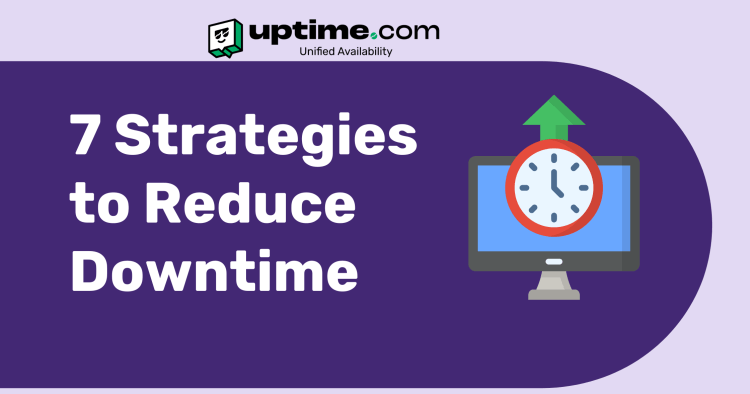
7 Strategies to Reduce Website Downtime
Website administrators and business owners know the frustration and potential revenue loss that can come with website downtime.
It’s like throwing a party and locking the front door—your guests (or, in this case, customers) cannot get in. To help you keep those digital doors open and the party going, here are some practical strategies you can use to minimize website downtime.
1. Regular Monitoring
Proactive monitoring is the first line of defense against website downtime. Implementing consistent monitoring is crucial.
Invest in a comprehensive monitoring solution that not only tracks uptime but also monitors performance metrics, user experience, and security. Early detection allows for swift response and issue resolution before users are impacted.
With Uptime.com, you can configure sophisticated uptime monitoring checks that are as simple as they are effective.
2. Redundancy Planning
Redundancy planning ensures that if one part of your system goes down, another can take over.
Build redundancy into your infrastructure by having backup servers and failover systems in place. In the event of a server failure or other technical issues, these systems automatically take over, ensuring continuous service availability. Redundancy is a key component of a resilient and fault-tolerant infrastructure.
Uptime.com’s robust monitoring solutions, including API Monitoring and Real User Monitoring (RUM), help you keep an eye on these redundancies to ensure they’re always ready to spring into action.
3. Effective Incidenct Response
They say a penny of preparedness is worth a pound of cure. It is very important to have the right tools for a specific job. For example, when a fire breaks out, you need a good hose and plenty of water.
Similarly, when your website faces issues, an effective incident response plan is your greatest asset. Prepare for the worst by having a well-defined plan in place. Identify potential risks, outline step-by-step procedures for incident response, and establish communication protocols. Regularly test the plan to make sure it’s effective and up-to-date.
Uptime.com offers incident management platforms, like Status Pages, allowing you to communicate updates swiftly and efficiently.
4. Performance Optimization
A slow website can be worse than no website because a slow website is turning away paying customers forever, while with no website, there’s nothing to be lost. With that reasoning, regular performance checks are essential.
Addressing performance issues proactively can prevent downtime during periods of increased activitiy. That’s why it’s important to identify and address potential performance issues through regular performance testing.
Tools like Page Speed Monitoring from Uptime.com can help you keep tabs on your site’s performance, ensuring it’s always in tip-top shape for your users. Regular optimization ensures your site isn’t just working but working well.
5. Staying Updated
DevOps and Site Reliability Monitoring are all about staying updated with the latest trends and technologies.
Uptime.com’s solutions are continuously improving which means offering you the latest in monitoring technology. You and your team need to keep your site updated to prevent downtime as well as content from becoming stale.
6. Educating Your Team
The strength of your response to downtime often lies in your team’s understanding of the systems powering it.
Uptime.com’s dashboards and analytics provide valuable insights that make it easier for your team to comprehend and react to issues promptly. Knowledge is power, and knowledge of these dashboards is a must for your team.
7. Your Digital Toolbox
Selecting the right monitoring tools is like choosing the right ingredients for a recipe. It makes all the difference. Uptime.com offers a range of tools like API Monitoring, Synthetic Monitoring, and more, tailored for different needs and scenarios.
Keep Your Website Running Smoothly with Uptime.com
Your website’s constant availability and peak performance is not just a goal; it’s a necessity. By now, you’ve seen the strategies and understand the importance so it is time to put them into action. Uptime.com’s tools are not just solutions; they’re your website’s guardians, ensuring that your digital presence is strong, reliable, and always engaging for your customers.
Don’t let worrying about website downtime keep you up at night. Be proactive! Sign up for a 14-day free trial with Uptime.com. No credit card is required, and you’ll get immediate access to tools that can transform the way you monitor and manage your website’s health. This is your chance to explore, experiment, and experience how our monitoring solutions can make a significant difference in your website’s performance.
Need More Information? We’re Here for You
If you’re still pondering over how Uptime.com can fit into your specific needs, then we need to talk. Contact us now, and our team of experts will be more than happy to guide you through our services and how they can be tailored to your website’s unique requirements. Remember, in the world of web monitoring, knowledge is not just power—it’s profit, performance, and peace of mind.
Embracing the right strategies with Uptime.com’s comprehensive monitoring tools can be the difference between a website that merely survives and one that thrives. So, take the leap, sign up for your free trial, or get in touch with us today. Let’s ensure that your website’s uptime is not just a goal but a guarantee.
Minute-by-minute Uptime checks.
Start your 14-day free trial with no credit card required at Uptime.com.
 Uptime.com Blog
Uptime.com Blog


